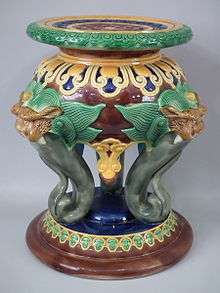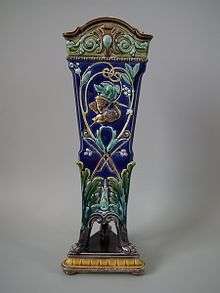Victorian majolica


- This article refers to the two types of earthenware made in 19th century between 1848 and 1900 that are together known as Victorian Majolica.
For mainstream pottery with an opaque white glaze decorated in colour, see Tin-glazed pottery or Maiolica for Italian Renaissance wares.
Victorian majolica includes two types of earthenware made in 19th century between 1848 and 1900
1. The mass produced widely available lead-glazed earthenware made in Britain, Europe and the USA, typically hard-wearing, with moulded surfaces, colourful translucent glazes,[1] in classical or naturalistic styles often with an element of High Victorian whimsy.
2. The very rare tin-glazed earthenware made in Britain only, primarily by Minton and Co. from 1848 to circa 1880, typically flat surfaces, opaque whitish glaze with brush painted decoration somewhat in the style of Italian Renaissance maiolica.
History
Victorian majolica was originated by Mintons Ltd, who exhibited it at the Great Exhibition of 1851 under the names
1. Palissy ware, (lead-glaze). The debt to the eccentric 16th century potter Bernard Palissy is obvious from its naturalistic plant and animal motifs.
2. Majolica, anglicizing the Italian maiolica, (tin-glaze).
The Illustrated London News reported with approval of Minton's two newest products at the Paris Exposition Universelle (1855) :
The collection of Palissy and Majolica ware, however, is that which appears to have created the greatest sensation among Parisian connoisseurs. The reader will remember that the main difference in these wares is that whereas the Palissy ware is coloured by a transparent glaze, Majolica ware contains the colour (opaque) in the material. The care and taste with which these manufactures have been brought by the Messrs. Minton to their present state of perfection, have been amply rewarded. Within a few days of the opening of the Exhibition all the specimens exhibited had been sold.[2]
Despite this reminder,[3] the public came to call Minton's Palissy Ware majolica ware; Palissy ware dropped out of use and majolica stuck. In the 1880s, the curators of the South Kensington Museum (now the V&A) tried to clear up the confusion by reviving the Italian spelling "maiolica" with an 'i' instead of a 'j' for Italian tin-glaze.[4]
Wedgwood began to manufacture majolica about ten years after Mintons. Wedgwood's glazes and modelling were denser and more formal than Minton's, but there were many pieces that displayed the naturalism and humour of Minton shapes. Wedgwood's majolica included cachepots, jugs, candlesticks, cheese bells, umbrella stands, sardine boxes, plates in naturalistic patterns, bread trays, etc. In Wedgwood's "greenware" the green glaze emphasizes the low relief patterning, typically of basketwork and foliage. Numerous smaller factories in the Staffordshire Potteries specialised in such green majolica wares in which the translucent glaze brought out the low relief of the cast body: some, like Wedgwood, marked their majolica with impressed stamps.
Majolica was influenced by the design of the old "Cauliflower" and "Pineapple" teapots that had been made by Thomas Whieldon, Wedgwood and other 18th-century Staffordshire potters. Both English and American majolica potters reproduced the "Cauliflower" pattern and other raised fruit, vegetable, leaf, and berry patterns, with green, yellow, pink, brown, light blue and purple-blue glazes. There is also a teapot of yellow corn and green leaves, similar to the old Whieldon "Pineapple" teapots, and a teapot, jug and sugar bowl of pink coral and green seaweed with accents of brown and blue, marked "Etruscan Majolica." Many late 19th-century majolica designs had rustic motifs with backgrounds of basketry and wooden-bound buckets decorated with moulded flowers, birds, fish and animals. Handles were made to resemble tree branches, rose stems and twined flowers and leaves.
Plates, jugs, teapots and other articles were moulded with the shapes of wild roses, lily pads and herons, begonia leaves, shells, coral, seaweed, corn and bamboo stalks, cabbage leaves, strawberries, ferns and sprays of flowers, borders of basketry and oriental motifs.
Many potteries responded to the popularity of majolica.
- The Trent Pottery, George Jones and Sons, made majolica cupids, shells, dolphins, birds, figurines and coral designs in numerous shapes. Their mark was a monogram of the initials "G.J." joined together. A beehive bread dish with a cover has a design of wild roses against a background of basketwork and has the Trent Pottery mark. Also flowerpots were made in bright colours and with raised designs of natural flowers.
 George Jones majolica flower-pot, coloured lead glazes on 'biscuit', then fired
George Jones majolica flower-pot, coloured lead glazes on 'biscuit', then fired - Royal Worcester made figurines, shell vases, wall pockets etc. marking most of their output with an impressed crown over rose backstamp, using a distinctive paler blue glaze.
- William Brownfield made wall pockets, jugs, game pie dishes, table ware etc. Some wares were impressed 'W B'(in a knot).
- T. Furnival and Sons made jugs and plates with raised oriental designs, which had borders of wickerwork in bold colour and glaze. Their mark, "Furnival," is impressed in the ware.

- Edward Steele of Hanley manufactured jugs, flower vases, teapots, dessert services also made majolica and centrepieces with fine colouring.
- Edward Banks and Thomas Thorley of Hanley manufactured bread trays, cheese stands, jugs, dessert services, trays, teapots, egg- holders and flowerpots. One of their dessert services has a chocolate coloured ground and a raised naturalistic design of ivy, ferns and anemones.
- Davenport and Banks (or Davenport Beck and Company) made many varieties of majolica. Their work was marked with a castle and the letters "D.B. & Co. Etruria" within an oval garter bearing the words "Trade Mark."
- Joseph Holdcroft of Longton.
- Brown-Westhead, Moore & Co
- Copeland & Garrett., successors to Josiah Spode
- Thomas Forester.

- Samuel Lear.
- Poole and Unwin.
- S.Fielding and Co., The Railway Pottery, Stoke on Trent

- Daniel Sutherland and Sons.
- James Woodward
- J.W. John Adams and Co., Hanley
- Edge, Malkin & Co, Burslem
European makers
France: Perret-Gentil, Sarreguemines, Massier, Choisy le Roi, Boch Freres, Longchamp, Luneville, Orchies, Nimy, Onnaing, Salins, Vallauris. Lonitz (Austria), Krause (Austria), Eichwald (Germany), Bloch (Germany), Villeroy & Boch (Germany), W S Schiller (Germany), Gustavsberg (Sweden), Rörstrand (Sweden).
Several American firms also made majolica, with the English born Edwin Bennett producing it in Baltimore as early as the 1850s.[5] The best known are Griffin, Smith and Hill of Phoenixville, Pennsylvania, whose Etruscan majolica made from 1880 to 1890 includes compotes with dolphin supports and flower, shell, or jewel cups, a design of coral weed and seashells, and tableware with leaves and ferns. Their mark was an impressed monogram, "G.S.H.," sometimes circled and with the words "Etruscan Majolica".
Majolica was also made by Odell and Booth at Tarrytown, New York, and by the Faience Manufacturing Company at Greenpoint, Long Island, whose mark is an incised "F.M. Co." Their pottery was dipped in coloured glazes, creating a streaked or marbled effect. Majolica was made at Evansville, Indiana. Work from the Chesapeake Pottery in Baltimore was called Clifton Ware and was marked "Clifton Decor 'R' " with the monogram "D.F.H.".
The Arsenal Pottery of Trenton, New Jersey, was making majolica as late as 1900 and exhibited Toby jugs in imitation of English Toby jugs at the World's Columbian Exposition, Chicago (1893)
Production had increased since 1875 but with fewer original examples and with less artistic enterprise. By the death of Queen Victoria in 1901, majolica production was at an end, superseded by Art Nouveau and Art pottery.
Much Victorian majolica appears in antique shops and auctions. It is popular with collectors and some old patterns have been reproduced.
See also
| Wikimedia Commons has media related to Victorian majolica. |
Notes
- ↑ http://www.ebooksread.com/authors-eng/c-drury-e-charles-drury-edward-fortnum/maiolica-tro/1-maiolica-tro.shtml
- ↑ The Illustrated London News, Nov. 10, 1855, p.561 http://www.londonancestor.com/iln/minton.htm
- ↑ https://archive.org/stream/britishmanufact08goog#page/n56/mode/2up/search/minton
- ↑ M is for Maiolica/majolica, Victoria and Albert Museum
- ↑ Schneider 1999, p. 19
In contemporary fiction
- The Majolica Murders by Deborah Morgan
References
- Karmason, Marylin J., and Stacke, Joan B., Majolica: A Complete History and Illustrated Survey,, Harry N. Abrams, Inc.
- Katz Marks, Mariann, "The Collector's Encyclopedia of Majolica", Collector Books
- Schneider, M. Majolica. Pennsylvania: Schiffer Publishing, Ltd. 1999.
- Arnoux, Leon, Lecture 23 Lectures on the Results of the Great Exhibition of 1851, David Bogue, 86 Fleet Street, London. 1853